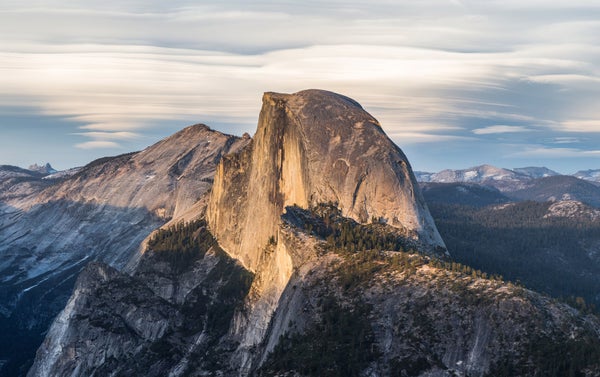The early Earth may have looked much like Iceland—where lava fields stretch as far as the eye can see, inky mountainsides tower above the clouds and stark black sand beaches outline the land. But the planet's color scheme gradually became less bleak. Today it also includes paler rocks, like the ash-colored granite of Half Dome in Yosemite National Park. Scientists remain uncertain as to when the world started this transition, but new evidence is narrowing the time frame.
A recent study suggests the shift had already transpired 3.5 billion years ago. The finding is hotly debated but may help scientists understand when tectonic plates—the interlocking slabs of crust that fit together like puzzle pieces far below our feet—started to wake up and shuffle around. The key to this idea is that light-colored rocks are actually dark ones “reincarnated.” In short, light rocks form when dark ones are pushed deep inside Earth—possibly when one tectonic plate slips under another in a process called subduction. Given that light-colored rocks were abundant billions of years ago, plate tectonics had likely already kicked in by then, the study researchers conclude.
Nicolas D. Greber, a geologist now at the University of Geneva in Switzerland, and his colleagues analyzed 78 sediment layers from around the world to pin down the ratio of lighter (or felsic) rocks to darker (or mafic) rocks. But it was not as simple as counting light stones versus dark ones, because both had long since eroded into tiny particles. Instead Greber's team looked at titanium. Although the metallic element is present in both types of rock, the proportion of its isotopes (chemically identical atoms with the same number of protons but different numbers of neutrons) shifts as the rock changes from mafic to felsic. Suppose you mix something that turns out both salty and sweet, Greber explains. Performing an analysis like his team did would give you “an idea of how much salt you added and how much sugar you added.” He had expected the earliest sediments in his sample, which dated back 3.5 billion years, to be composed mostly of mafic particles. To his surprise, roughly half the particles were felsic. His group reported the findings in September in Science.
On supporting science journalism
If you're enjoying this article, consider supporting our award-winning journalism by subscribing. By purchasing a subscription you are helping to ensure the future of impactful stories about the discoveries and ideas shaping our world today.

Credit: Amanda Montañez; Source: “Titanium Isotopic Evidence for Felsic Crust and Plate Tectonics 3.5 Billion Years Ago,” by Nicolas D. Greber et al., in Science, Vol. 357; September 22, 2017
This result goes against the predominant view in the field—that the early Earth was still cloaked in dark mafic rocks 3.5 billion years ago—says Jun Korenaga, a geophysicist at Yale University, who was not involved in the study. “It's very refreshing to see that a group is going in this direction,” he says. “They tried to shake [up] the community, and this is a highly welcome input.”
Scientists have long argued over how long ago these crustal plates began to stir, with estimates ranging from one billion to 4.2 billion years. Jonathan O'Neil, a geochemist at the University of Ottawa, who was not involved in the new work, points out that several recent studies peg the beginning of plate tectonics to around three billion years ago. He notes that there is no consensus yet, however. And that is a major problem, if scientists want to understand the evolution of early Earth. Shifting plates dramatically reshape the planet, not only by sculpting ocean basins and thrusting up mountain ranges but also by altering the composition of the atmosphere and oceans. This would have affected the supply of nutrients available to the fledgling life on our young planet. In fact, some scientists contend that plate tectonics was crucial to the origin of life.
With such high stakes, it is easy to see why scientists are cautious about settling on a firm origin date. For example, Paul Tackley, a geophysicist at the Swiss Federal Institute of Technology Zurich, disagrees with Greber's latest interpretation. He maintains that felsic rocks can form anytime mafic rocks sink deep within Earth—and not only along subduction zones. When a volcano erupts, for example, the newly released lava can push down mafic rocks until they become so deeply buried that they melt under the high subterranean pressures and temperatures, transforming into felsic rocks even without plate movements.
Although Greber agrees felsic rocks can form this way, he argues that such a high felsic-to-mafic ratio cannot be explained by Tackley's explanation alone. O'Neil and Korenaga agree with Greber that subduction is the most likely factor. But that would not necessarily mean that subduction—and therefore plate tectonics—was occurring on a global scale. Instead many experts speculate that early plate tectonics activity was probably more episodic, starting and stopping locally multiple times before it became a continuous and worldwide process. The only way to know for sure is to analyze more sediments—something Greber hopes to do in the future.
